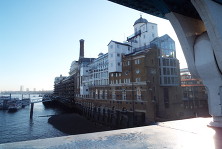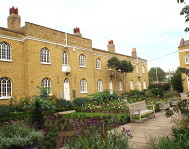








Charlotte Court / former Asylum for
the Deaf and Dumb
Charlotte Court, just by the Bricklayers Arms roundabout on the Old Kent Road, is an apartment building converted from the former London County Council School for the Deaf. It was built in 1886 on the site of the Asylum for the Deaf and Dumb, one of the earliest institutions for the education of deaf children. The Asylum for the Deaf and Dumb had been built in 1807-09 and founded by the Rev John Townsend of Jamaica Road Chapel, Bermondsey and the Rev Henry Cox Mason, curate of Bermondsey, and Henry Thornton, MP for Southwark. The names of the first two founders are commemorated in the names of the streets close by.
The Asylum’s first home was in Grange Road, Bermondsey, which opened in 1792 when Rev. Townsend became familiar with the difficulty of a deaf child within his parish who was sent by his parents to the privately run Thomas Braidwood’s Academy for the Deaf in Edinburgh. He was struck by the boy’s keen intellect and agreed with the boy’s mother, Mrs Creasey, there was a need for a charitable institution in London for the education of the deaf. With the support of Mason and Thornton, he opened the Asylum at a time when the educational needs of the deaf were largely ignored. When the school opened there were six pupils whose number increased twice yearly as more pupils were selected by the Committee of Governors of the Asylum. Candidates were between the ages of six and twelve years of age and of “sound mind”.
Yet the numbers on the waiting list still kept growing and it was only possible to admit half of the candidates. It was clear larger premises were required and Rev. Thornton launched a subscription for a new building. The patronage of the Duke of Gloucester was gained and he laid the foundation stone of the new building in 1807. The building was completed two years later and able to accommodate 200 pupils. The scope of the education received was to evolve from the teaching of religious instruction and a basic educational groundwork through to equipping pupils with a means by which to earn their living independently upon completion of their education. To this end, pupils received training in trades such as mechanics and design, and in some cases apprenticeships were paid for.
Joseph Watson, nephew of Thomas Braidwood, was engaged as a teacher in the Asylum’s early days and became its head teacher. He was unwavering in his belief that deaf and dumb pupils should be treated the same as those who were able to hear. “Persons born deaf are, in fact, neither depressed below, nor raised above, the general scale of human nature, as regards
their dispositions and powers, either of body or mind.” He also believed that teaching sign-language which, while facilitating communication between the deaf, increased isolation. He believed that lip-reading which used the same language common throughout the country, was to be encouraged and would aid integration.
In 1875 a new school was opened in Margate where the older pupils went to be educated and, when the old asylum was demolished in 1886, the younger pupils were sent there temporarily whilst the new school was being built. At this time, a London Board School, called the Townsend Street School and still thriving, was also built on land to the rear which had previously been the Asylum’s garden. In 1902, the younger pupils were moved permanently to the school in Margate which was subsequently named the Royal School for the Deaf. It closed in 2015.
The Old Kent Road school was sold to the London School Board and came under the authority of the London County Council two years later. A school for physically handicapped children was opened on the ground floor and a smaller school for deaf children on the second floor. The school survived until 1968 when a new school opened in Grove House in Elmcourt Road, Norwood which closed in 2002.
Planning permission for the building in Old Kent Road for a change of use from school to residential was granted in 1994 and the building subsequently converted.
Web discoveries
- UK Casino Not On Gamstop
- UK Casino Not On Gamstop
- Non Gamstop Casino
- Casinos Not On Gamstop
- Non Gamstop Casinos
- Non Gamstop Casinos
- Non Gamstop Casino
- Casino Sites Not On Gamstop
- Slots Not On Gamstop
- Casinos Not On Gamstop
- UK Betting Sites Not On Gamstop
- UK Casino Not On Gamstop
- Best Non Gamstop Casinos
- Betting Sites
- Non Gamstop Casino Sites UK
- Best Non Gamstop Casinos
- Non Gamstop Casino
- Casinos Not On Gamstop
- Non Gamstop Casino Sites UK